Marine Protected Area network: 2024 report to the Scottish Parliament
A report to the Scottish Parliament on progress being made in implementing Scotland's Marine Protected Area (MPA) network.
5. Scotland's contribution to other MPA networks
The UK Marine Policy Statement, adopted in 2011, identifies MPAs as a tool to help achieve Good Environmental Status under the UK Marine Strategy (UKMS) Regulations. It highlights that MPAs should be used to conserve, where appropriate recover, and halt the loss of biodiversity in our seas.
Summary statistics regarding Scotland's contribution to MPA networks are provided in Annex 1.
This section describes Scotland's contribution to MPA networks at various scales, including:
- the network of nature conservation sites in UK Waters[5]
- spatial protection measures under UKMS consisting of nature conservation sites and OECMs
- the OSPAR MPA network across the North-East Atlantic.
Contribution to the UK network of conservation sites
In Scottish waters there are currently 233 MPAs for nature conservation purposes. These form a significant part of the UK network of conservation sites[6], which consists of 729 MPAs in total (Figure 7).
Of the total area of the UK network of conservation sites[7], these 233 MPAs contribute in excess of 228,000 km2 , representing just over 67%. This is roughly proportional to the area of UK seas which lie within Scottish waters.
The Marine Acts include three conditions that the UK network must achieve:
- Contribute to the conservation or improvement of the marine environment
- Represent the range of features present in the UK marine area
- Reflect that the conservation of a feature may require the designation of more than one MPA.
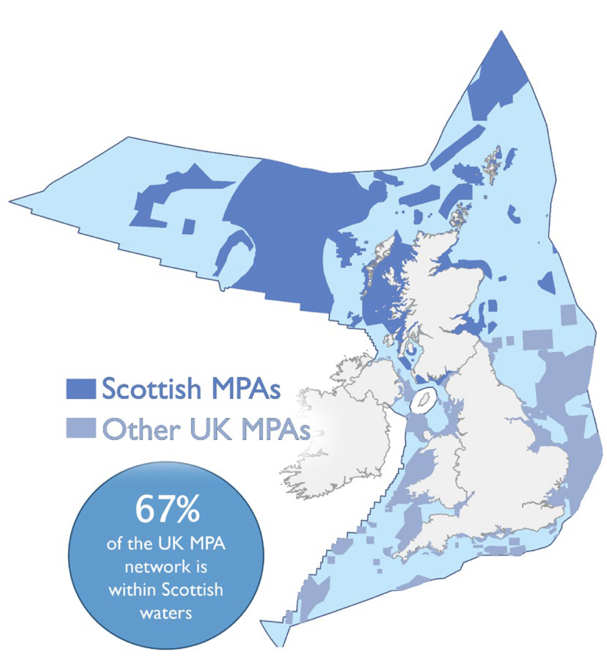
Marine ActConditions |
Contribution made by Scottish MPA network |
Progress |
|---|---|---|
Contribute to conservation or improvement ofmarine environment |
Scotland's seas host 233 out of a total of 729 MPAs in UK waters and just over 67% of the UK MPA network by area. All MPAs contribute towards conservation of the marine environment. 79 MPAs in Scotland include objectives to restore or recover features and therefore also contribute to improvement of the health of the marine environment. |
Achieved for establishing the network. Work in progress to implement management. |
Represent therange of featurespresent in Scottish waters |
Habitats: The network includes all widely distributed habitats, large scale features and all rare, threatened and/or declining habitats for which MPAs could be identified. |
Achieved |
Species: The network includes mobile species[8] (marine mammals, birds and fish) and low or limited mobility species for which MPAs could be identified. |
Achieved |
|
Reflect that the conservation of a feature may require the designation of more than one MPA |
Habitats: There is replication of the majority of all widely distributed habitats on a regional basis. The network has replication of the rare, threatened and/or declining habitats where there is evidence to support replication (with the exception of oyster beds). |
Achieved |
Species: There is replication of 54 of the 75 species represented in the Scottish MPA network. There is replication achieved for all species where there is evidence to support MPA selection. For the majority of species with no replication in the MPA network (67%), there is replication in Scottish protected areas above MHWS (8 species) and/or in the UK network of conservation sites (11 species). |
Achieved. |
Further details on how habitats and species are represented and replicated is provided in Annex 4. This demonstrates the coherence of the Scottish MPA network and the significant range of biodiversity that it protects.
Contribution to Good Environmental Status under the UK MarineStrategy
The UK Marine Strategy (UKMS) is prepared under the Marine Strategy Regulations 2010. The UKMS aims to achieve and maintain the good environmental status of the UK's seas. Achieving good environmental status means protecting the marine environment, preventing its deterioration and restoring it where practical, while allowing sustainable use of marine resources. The UKMS requires that policy interventions (known as a programme of measures) for achieving good environmental status include spatial protection measures, to contribute to coherent and representative networks of marine protected areas.
Scotland's MPA network is a key tool in contributing to achieving good environmental status, particularly in ensuring biodiversity is protected, conserved and where appropriate recovered, and loss of biodiversity halted. It also contributes to other elements of good environmental status, such as the protection of seafloor ecosystems.
The UKMS divides the UK's waters into two sub-regions, Celtic Seas and the Greater North Sea, and Scotland's seas form part of both of these sub- regions.
For the purposes of this assessment, all of the nature conservation sites in Scotland's seas are included. The one OECM recognised in Scotland's seas, West Rockall Mound, is also included because this contributes to the conservation of marine biodiversity, and therefore contributes to achieving and maintaining good environmental status. We have designated MPAs for marine biodiversity in 44% of the Celtic Seas and 11% of the Greater North Sea for the parts of these sub-regions in Scottish waters (Figure 8).
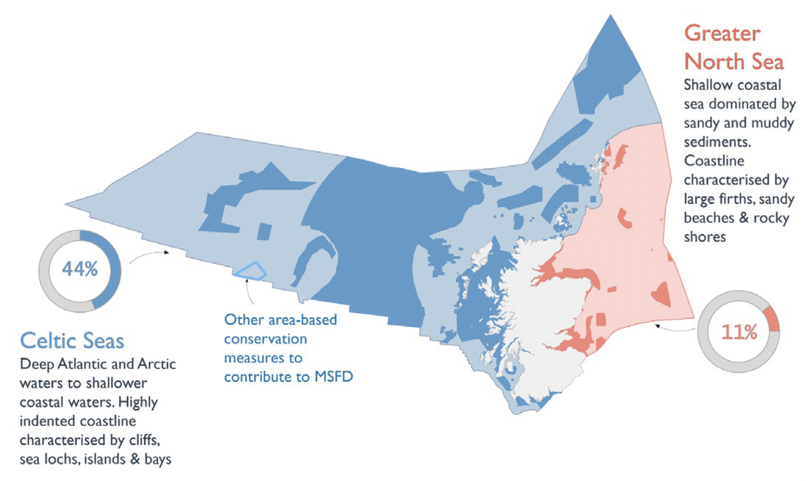
These spatial protection measures are well distributed across our seas and are representative of the wide range of habitats and species present. This is a significant contribution towards achieving GES, which will be further enhanced by completing delivery of management measures. Further details on representation and replication of habitats and species in the Scottish MPA network can be found in Annex 5.
Contribution to international MPA networks
Scotland's MPA network also contributes to international networks at North- east Atlantic and global scales.
Internationally we have commitments to MPAs and other spatial conservation measures under the OSPAR Convention[9] and the United Nation's Convention on Biological Diversity and Sustainable Development Goals. Together, they provide a global framework that requires delivery of MPA networks by Contracting Parties.
As part of the Kunming-Montreal Global Biodiversity Framework, which was agreed at the Convention on Biological Diversity (CBD) at COP15, a global target has been set to protect 30% of the planet for nature by 2030 (known as '30x30'). Countries, including the UK, are expected to contribute to this global goal through domestic action to increase coverage of effectively managed protected areas.
Scotland is exceeding these international commitments in area terms.
In addition the Scottish MPA network is broadly representative of the habitats and species found in our seas. Our system for consenting and licensing activities helps us to manage our network. Ongoing work is primarily focused on delivery of required management measures for fishing activity (see Section 8).
At a regional level, a key aim of the Scottish Government has been to make a significant contribution to the OSPAR MPA network in the North-east Atlantic. The OSPAR maritime area is split up into regions which are different from those defined under the UKMS, even though the names are the same in some cases.
Scotland has waters within four OSPAR regions enabling an assessment of relative contribution of Scottish MPAs to each of those. These regions are:
Region 1: Arctic Waters
Region 2: Greater North Sea
Region 3: Celtic Seas
Region 5: Wider Atlantic
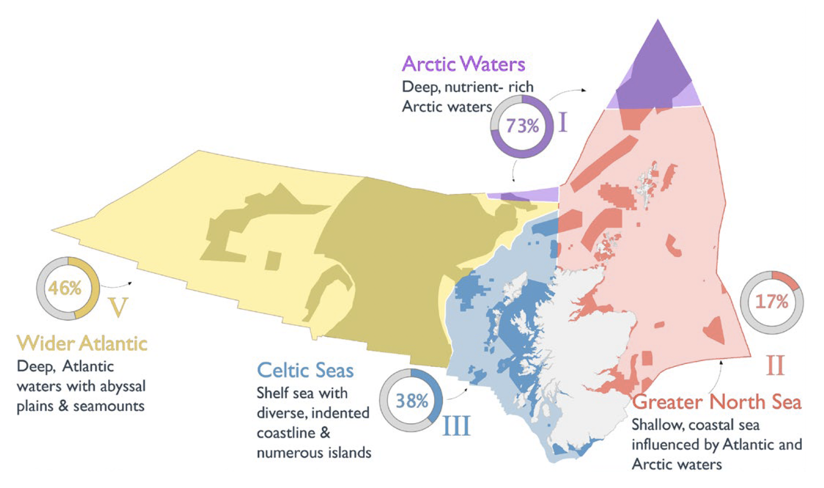
In spatial terms Scotland's seas make up a relatively small proportion of the overall OSPAR maritime area but the Scottish MPA network covers more than 15% of our seas that falls within each OSPAR region.
Spotlight
Scotland's contribution to the OSPAR network for blue mussel beds
Blue mussel beds (Figure 10) are typically diverse habitats that can form reefs on the shore and are also found on sediment in deeper water down to around 20 metres. They help stabilise sediment and provide a home for many plants and animals as well as an important food source for some species. There is evidence of decline of intertidal blue mussel beds in Scotland (Burrows et al., 2017, West et al., inprep) and the wider UK and OSPAR regions. Intertidal blue mussel beds are an OSPAR threatened and declining habitat.
Blue mussel beds are a protected feature in the Scottish MPA network and the seven MPAs where they are a protected feature are shown in Figure 11. Five of these sites inlcude intertidal mussel beds and make a significant contribution to the overall OSPAR MPA network for blue mussel beds (Figure 11). The contribution does not include the two subtidal blue mussel beds MPAS.
There is also work underway to review the status of blue mussel beds in Scotland to help progress OSPAR recommendations for intertidal blue mussel beds on sandy sediments (West et al., in prep). Liaison within the UK and wider OSPAR contracting parties with the same threatened and declining species and or habitats, helps share knowledge, evidence and experiences.
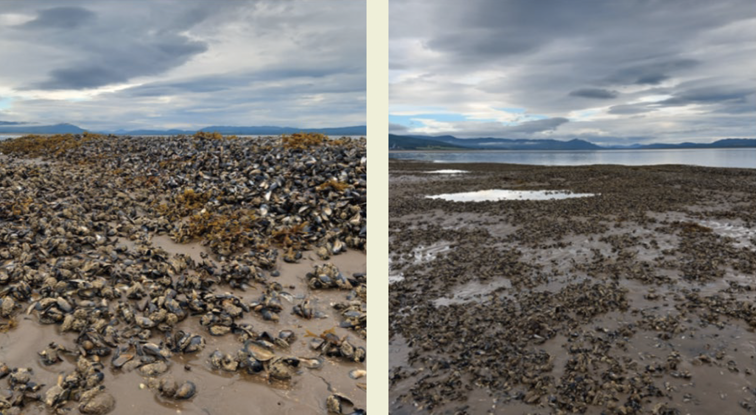
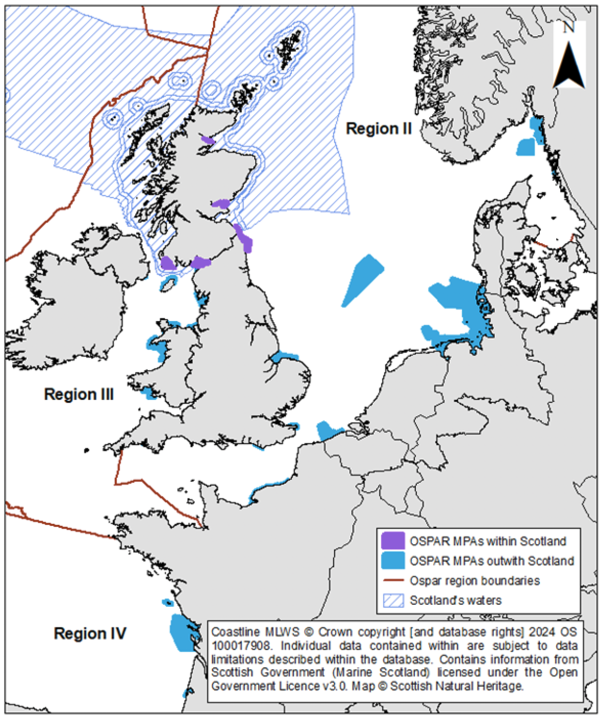
Contact
Email: marine_biodiversity@gov.scot
There is a problem
Thanks for your feedback